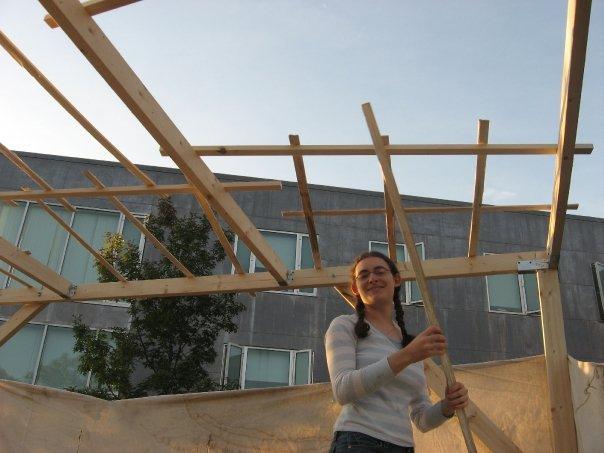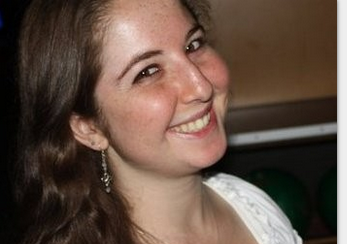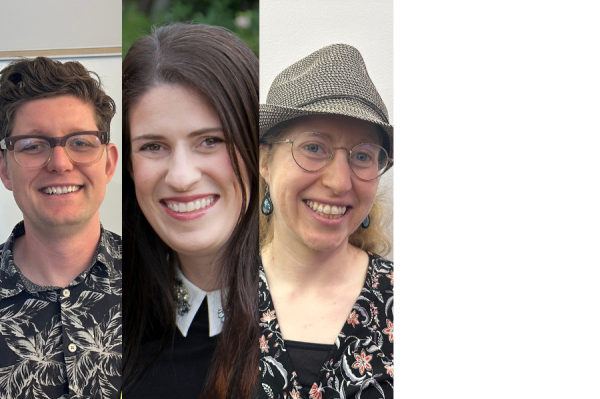Life beyond the bubble: Alumni find many shades of Jewish life on campus
Photo Credit: Gideon Klionsky, used with permission
IF YOU BUILD IT… Deborah Thompson ’07 building a sukkah at Brandeis last month. The Boston-area university is one of the most popular for Shalhevet alumni, and has everything Pico-Robertson has including large numbers of students observing holidays and Shabbat.
November 1, 2010
Shalhevet prides itself on being a school that prepares students to study in the top secular universities and observe their religion wherever they find themselves. But do students actually want to venture outside the Orthodox Jewish bubble?
Based on interviews with more than a dozen recent alumni, the answer, it seems, is predominantly “no.” A steady majority of graduates has been going to schools with Jewish opportunities near, equal to, or greater than Shalhevet’s.
Among the 15 colleges attended by the most alumni, eight have daily or weekly Orthodox services, seven have full kosher meal plans, and the school’s population is on average about 20 percent Jewish. See related story.
“It’s very common for kids to choose similar schools [to their high schools],” said Dr. Steven Mercer, director of college counseling. “I don’t know how to explain it – it’s just human nature.
“But there are certainly exceptions,” he continued. “It’s interesting to compare Shalhevet to other Jewish schools. The colleges that their students go to are much more limited” – that is, even less varied in their religious opportunities than Shalhevet grads’ choices.
Most seniors apply to a wide range of places but ultimately go to a relatively Jewish school. Among these, there is still a variety: some have Orthodox opportunities around every corner, while some have Orthodox opportunities but a smaller community to share them with.
Others have a large Jewish population but not as many religious options, and some leave students making a much larger effort to lead Jewish lives. But over the past few years, this fact remains constant: the majority of students all end up going to the same 15 or 20 universities and colleges.
Typical is New York University, where at least eight Shalhevet alumni are now enrolled. The student body is more than half Jewish, but more to the point, the Orthodox community is huge. In a recent year, 104 entering freshmen arrived after spending a gap year in Israel.
And speaking of getting outside the bubble, the name of NYU’s Modern Orthodox group on campus is “Shalhevet.”
“The religious community at NYU is probably one of the best because it’s so diverse,” said Tamar Rohatiner ‘06, an NYU senior who is now president of the east coast’s Shalhevet.
“For example, on Friday nights there are three minyans going on at once: Orthodox, Conservative, and Reform, plus the Chabad. But no matter where you were for davening or where you eat your meal, everyone’s always united at the end of the night.”
NYU offers a full kosher meal plan in the small-ish “kosher caf” that adjoins one of the main dining halls. Observant freshmen get frequent invitations to Shabbat lunch at older kids’ off-campus apartments, and this year there were two sukkahs to choose from, one at Hillel and one at Chabad.
There’s even a Jewish a capella singing group at NYU, “Ani V’Ata,” which isn’t so unusual, it turns out. Columbia – Barnard, Penn, Brandeis, Wash. U. in St. Louis, and even Tufts University – which has no Orthodox community at all – all have them as well, and the University of Maryland has two; they compete for singers.
Maryland, Brandeis, Penn and Barnard round out the most popular destinations for Shalhevet grads in terms of sheer numbers of alumni attending, and this correlates with their concentrations of observant Jews and the activities and services to support them. All have at least five Shalhevet alumni currently enrolled and all offer kosher options for almost every meal, along with daily Orthodox *minyanim.
“It’s great actually – there are always kosher options, and Shabbat dinners every Friday,” said Tziporah Thompson ’11, who left Shalhevet a year early to enroll at Brandeis and is now a freshman there.
“I think what I like most is that the services are run by students who want to be there. You come if you want to come and a lot of people do.”
According to Talia Spitzer ’09, the Columbia-Barnard Hillel hosts about 250 Orthodox students on an average Shabbat, and also hosts in charge of Israel advocacy programs and Hillel “formals” for Jewish kids.
“The Orthodox community has events almost weekly (ice cream study breaks, interesting Jewish lecturers) and fun games to get to know the other Orthodox kids on campus, like last week was a massive game of ‘Asassin.’” wrote Talia in an e-mail to The Boiling Point.
“It is never as easy to do something when you individually have to choose to get involved versus your family automatically just being involved,” Talia added. “But I am in a place where if I want it, it’s there, and I really enjoy that.”
There are also schools like Washington University in St. Louis, which have all the necessary Orthodox options but lack the level of student participation that NYU or Barnard have, making it somewhat harder to lead a religious life there even though there’s nothing missing.
“Orthodox life as Wash. U. is however you want it to be,” said Louis Keene ’08, a sophomore there. “If you want to be involved in Hillel, you can. I go to Chabad for Friday night dinner, which is free. During the week there’s Shacharit in a freshman dorm.”
Wash. U., where three Shalhevet alumni are currently enrolled and two more are headed after their gap year in Israel, has a full kosher kitchen on campus that serves in the main cafeteria. Kosher sandwiches and salads are available everywhere on campus that cold food is sold.
But while almost a third of the students there are Jewish, there’s no real Shabbat “scene.”
“Shabbat looks like a Saturday at any school,” Louis said. “There’s always a lot of Jews walking around – that one kid that you’ve eaten lunch with so many times that you always thought was Catholic turns out to be Jewish. But on Shabbat it doesn’t look any different–no one dresses differently.”
A
nother school with a vibrant Jewish life is Oberlin College, and it is rarely heard of in Shalhevet. Located near Cleveland, Ohio, Oberlin offers a full kosher meal plan in the kosher dining hall in addition to a separate “Kosher-Halal co-op.” Halal meat follows the dietary restrictions of Islam, which are similar to kashrut in their avoidance of pork.
“All of the students in the co-op take turns cooking and grocery shopping, instead of paying for a meal that’s already been prepared,” said senior Jaclyn Kellner, who recently visited Oberlin on a college tour.
“It’s Kosher and halal — Muslim — because they’re very similar, and they keep the stricter part of both, like Kashrut for Jews and not mixing alcohol in the food for Muslims.”
While Oberlin – which no Shalhevet graduate has ever attended – is very close to NYU and Wash. U. in its Orthodox amenities, there are many schools such as the University of Wisconsin that have fewer religious opportunities but where Jewish life is still present.
“I’d say [the Jewish life is] very outspoken in that there are a lot of Jews here,” said alumnus Jonah Braun ’07, a senior at Wisconsin this year.
“A lot of us know each other and there are a lot of Jewish groups. The big thing here is Friday night dinners and all three groups are full on Friday nights.”
Jonah said there’s not much of a following for other types of religious observance, but that kosher food is available at the university’s Hillel.
“I don’t know if it’s easy to stay religious but if you really want to, you definitely can,” Jonah said.
George Washington University in Washington, D.C., is another school somewhere between just-like-Shalhevet and “too far outside the bubble.” Its three minyanim pray only on Friday nights.
Penina Smith ’09, a GW freshman, said having to help build the community you want has its good points, too.
“The Orthodox community at GW is growing,” said Penina. “With more and more Orthodox students coming here for school, it gets easier for students to lead Orthodox lives.
There’s kosher food, she said, but not on Sundays, and there are no daily minyanim.
“But the more people push for it, the more likely it will happen,” she said. “I’m starting to get really active in the community and I love it; I’m glad that I’m at GW even if I need to make more of an effort to have a Jewish life.”
Penina is not alone in thinking Orthodox life on campus may be on the upswing. Johnson and Wales University in Rhode Island, which specializes in preparing students for the hospitality industry, now offers a full kosher meal plan – even though there are only 100 Jewish students out of about 9,500.
This fall, Meital Cafri ‘10 became the first Shalhevet graduate in Dr. Mercer’s records to enroll there. An Orthodox friend of hers studying to be a chef started the kosher culinary program there last year.
“The kosher meals are usually frozen foods, and usually you have to call the kitchen ahead so that they can prepare the food in advance,” said Meital. “If you want to be involved, you must take action and find out about things on your own.”
Meital said Jewish students at JWU often go to the Hillels at nearby Brown University or the Rhode Island School of Design.
“JWU’s Hillel is just forming,” Meital said.
According to a recent article on JTA.org, admissions officers at schools with few Jews say they are looking to “increase diversity” – which includes, apparently, attracting more Jewish students.
“Jewish students bring certain assets, from leadership skills and good academic records while they are on campus to a propensity for donating to the school once they graduate,” the JTA article said. (http://tinyurl.com/2bzpc9s). It said that many such colleges have seen an increase in Jewish enrollment since bringing a Hillel house to their campuses in recent years.
Dr. Mercer is the West Coast vice president of a newly formed organization for college counselors at Jewish high schools. The organization, called the Counselor Advocacy for the Jewish University Experience (CAJUE), hopes to put together a database on various campuses’ Jewish life.
CAJUE members plan to visit campuses, building relationships with their Hillels and Chabads and checking out their meal plans.
“We try to understand what kind of kosher food is available, if it’s on campus, and what opportunities for observances there are,” Dr. Mercer said.
S
till, not all Shalhevet grads play it so safe. Every year a few alumni head to colleges that are hardly religious at all compared to the familiar Pico experience in Los Angeles. Although Jewish enrollment at UC Santa Cruz is almost 22 percent, for example, the religious life there is much different from schools with similar percentages.
“You can’t find kosher meals except for Shabbat, and there’s no davening except for Chabad and Hillel which are both off-campus, so you have to take a bus there anyway,” said Matt Sherer ’09, a freshman at UC Santa Cruz. “If you keep Shabbat, this isn’t the best campus for you.”
Leora Weinstock ’10, has had a similar experience as a freshman at USC Film School. USC is about 11 percent Jewish and only offers kosher food on Shabbat and holidays.
“There are not many religious Jews at all here,” Leora said via Facebook. “I am one of the more religious, and I’ve made Jewish friends at Chabad, but you really need to make more of an effort to keep Shabbat. Kashrut is easier because I just basically am vegetarian on campus, but there isn’t a kosher meal plan.”
Then there’s the problem of no University of California campuses having observant communities like the ones at NYU, Brandeis or Maryland. UCLA has a “Bayit” – an off-campus house where religious Jewish students can live and observe kashrut and Shabbat – and kosher food is now available in the Hillel Building just off campus.
UC Berkeley has a Bayit as well, along with Chabad, many Jewish activist political groups, and even a Jewish a capella group called Kol Hadov (“Voice of the Bear”).
“Everything in the house is kosher,” he said, “and there’s a lot of vegetarian food but not much demand. The community is growing right now, so a lot of the stuff is only forming as we speak.
“It’s not the easiest place to be Jewish,” Ricky added. “It’s not actively made easy for you, but it is entirely possible.”
Dr. Mercer said seniors consider a number of factors when narrowing down their list of colleges, and a Jewish life is not always one of them. While being able to observe Judaism may be important, they also take into account the location, academics and cost of colleges, along with particular academic programs like film or business.
“If it doesn’t come up, I ask,” Dr. Mercer said. “Sometimes a student doesn’t know how important it is to them.”
Judaic Studies teacher Rabbi Hertzie Richler said the very problem of not knowing means Jewish life should be an important consideration.
“I think it’s very important to go to a Jewish college,” Rabbi Richler said, “since you might not realize when you live in the bubble how proud you are to be in it. So when you go somewhere that doesn’t have anything, you are lacking a very important part of you.”
Does that mean college shouldn’t* take you outside the confines of what’s most familiar? Not at all, he said. There are so many new cultures and possibilities infused into every college that having many Orthodox opportunities is not going to limit anyone’s post-high school experience – nor should it.
“I think living in the bubble means that one doesn’t have choices,” Rabbi Richler said. “When you go to another school, where you have the choice, you’re not really in the bubble.
“Living outside the bubble means you have all types of choices, and when you go somewhere like Maryland and you happen to choose a path, that’s called living outside the bubble.”
Even alumni at the most observance-friendly universities seem to agree with that assessment. NYU, for example, has a huge percentage of international students, and Shalhevet alumni like Tamar have friends from all over the world including Hindus and Muslims from places as far away as Pakistan, along with Americans from everywhere.
“It is very, very easy to in a Jewish bubble, even in a secular college,” said Molly Keene ‘06, a senior at NYU. “In a way, it might be harder then (at least at NYU), to choose the *other path and make non-Jewish friends. The great thing about NYU is that we do have a really great, thriving Jewish community, but it is also a very international school in a very international city – and that is really valuable, and something we didn’t have growing up in Beverlywood.”
This story won a National Award for In-Depth Reporting by an Individual in the 2011 International Writing and Photo Contest of the Quill and Scroll Society.














